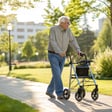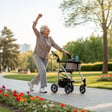Staying active doesn't always require fancy equipment or gym memberships. For many, especially those with mobility concerns, chair exercises offer an accessible way to improve circulation.
Why Chair Exercises Matter for Circulation
Poor circulation can lead to various health issues, from swelling and numbness to more serious conditions. When we sit for extended periods, blood tends to pool in our lower extremities, creating that uncomfortable "pins and needles" sensation.
"Regular movement, even while seated, stimulates blood flow throughout the body," notes the British Heart Foundation, which recommends chair-based routines for people with limited mobility.
Chair exercises specifically target this problem by engaging muscles that help pump blood back to the heart. They're particularly valuable for:
- Seniors with mobility limitations
- Office workers who sit for hours
- People recovering from injuries
- Those with chronic conditions affecting movement
- Travelers on long flights
Chair Exercises for Seniors
As we age, maintaining circulation becomes increasingly important. The NHS recommends these gentle exercises that are particularly suitable for older adults:
Ankle Circles
- Sit tall with feet flat on the floor
- Lift one foot slightly and rotate your ankle in circles
- Do 5-10 circles in each direction
- Switch to the other foot
These simple movements help pump blood from your feet back toward your heart, reducing swelling that commonly occurs in older adults.
Seated Marching
This exercise mimics walking while eliminating pressure on joints.
- Sit with good posture, back not touching the chair
- Alternately lift your knees as if marching in place
- Start with 20-30 seconds and gradually increase duration
- For added challenge, lift knees higher as stamina improves
According to HelpGuide.org, this exercise "engages core muscles while promoting healthy blood flow to the legs," making it perfect for seniors with balance concerns.
Office-Friendly Circulation Boosters
For those desk-bound during workdays, circulation issues can develop surprisingly quickly. These discreet exercises can be done without drawing attention:
Calf Pumps
- Sit with feet flat on floor
- Keeping heels on ground, lift toes and front of feet up
- Lower feet, then raise heels while keeping toes on floor
- Repeat 10-15 times, several times throughout day
"This simple movement activates the calf muscles, which act as natural pumps for returning blood from the legs," explains Healthline.
Seated Leg Extensions
- Sit tall near edge of chair
- Extend one leg straight out, foot flexed
- Hold briefly, then lower
- Repeat 8-10 times per leg
This exercise engages the quadriceps, large muscles that help move substantial amounts of blood when activated.
Preventing Blood Clots During Travel
Long flights or car rides significantly increase clot risk due to prolonged immobility. The National Blood Clot Alliance recommends these in-flight exercises:
Seated Ankle Pumps
- While seated, lift feet off floor
- Point toes forward, then flex feet back
- Repeat for 30 seconds every hour
Knee-to-Chest Lifts
- Lift one knee toward chest
- Hold briefly, then lower
- Alternate legs for 1 minute
"These movements help prevent potentially dangerous blood clots that can form during long periods of immobility," warns StopTheClot.org.
How Can I Tell If My Circulation Is Improving?
This is a common question, and several signs indicate better circulation:
- Reduced swelling in extremities
- Warmer hands and feet
- Less numbness or tingling
- Improved skin color
- Faster healing of minor injuries
The British Heart Foundation notes that "improvements may be gradual rather than immediate," so consistency matters more than intensity.
Beyond Exercise: Supporting Healthy Blood Flow
While chair exercises provide direct circulation benefits, other habits enhance their effectiveness:
- Stay hydrated throughout the day
- Avoid crossing legs when sitting
- Wear compression socks for long periods of sitting
- Elevate legs when possible
- Take brief standing breaks every 30-60 minutes
"Combining regular movement with these supportive practices creates the best environment for healthy circulation," according to vascular health experts.
Getting Started Safely
Begin with just 5-10 minutes daily and gradually increase duration as your body adapts. If you experience pain (not just muscle fatigue), stop and consult a healthcare provider.
Remember that consistency trumps intensity—daily gentle movement provides more circulatory benefit than occasional intense sessions.
Disclaimer: This information is provided for educational purposes only and is not a substitute for professional medical advice. If you have health concerns or conditions affecting mobility, consult your healthcare provider before beginning any exercise program.
Tags

About Evelyn Grant the Author
Evelyn Grant is a trailblazer in the world of cycling fashion, known for combining functionality with style. With over a decade of experience, she designs apparel that meets the demands of avid cyclists while making a bold fashion statement.
Recommended Articles
4 Everyday Drinks Being Studied for Circulation Support
Explore 4 everyday drinks that may enhance circulation, including herbal teas, coffee, red wine, and beetroot juice. Discover their health benefits.
Why More Seniors Are Considering Compact Mobility Tech
Explore how compact mobility tech enhances independence and quality of life for seniors, making daily activities more accessible and enjoyable.
Why More Seniors Are Replacing Walkers With This Sleek Device
Discover why seniors are opting for sleek mobility devices over traditional walkers, enhancing their independence with style and functionality.
2025 Cadillac CT4 Combines Performance With Refined Luxury
Discover the 2025 Cadillac CT4, where thrilling performance meets luxury, featuring advanced safety, elegant interiors and powerful engine options.
2025 Lexus RX Keeps the Luxury SUV Crown With Smarter Features
The 2025 Lexus RX redefines luxury SUVs with advanced tech, safety features, and a focus on comfort for an unparalleled driving experience.




